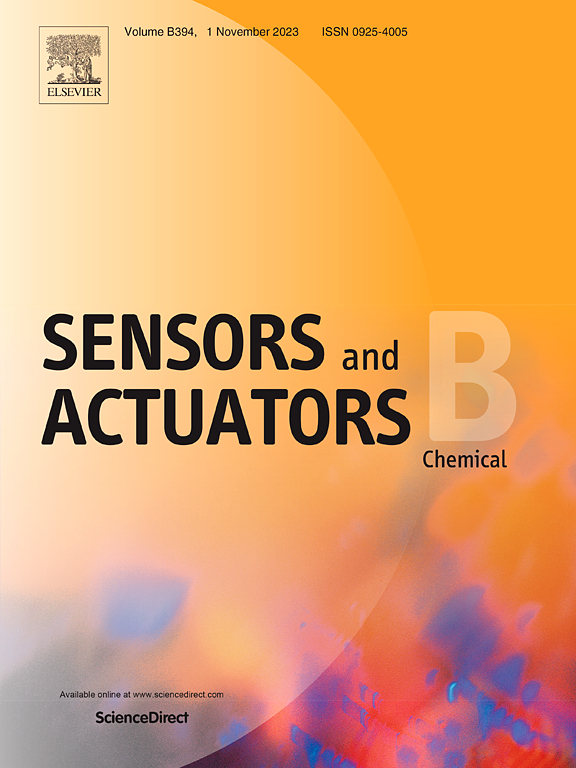Low-triggered-potential electrochemiluminescence platform based on anodic-emitting Yb-MOF for sensitive detection of APE1
IF 8
1区 化学
Q1 CHEMISTRY, ANALYTICAL
引用次数: 0
Abstract
Porphyrins possess excellent electrochemiluminescence (ECL) properties but suffer from aggregation-induced quenching (ACQ) in aqueous solutions. Metal-organic frameworks (MOFs) can effectively mitigate this issue by restricting porphyrin aggregation. However, existing studies predominantly focus on cathodic ECL emission at highly negative trigger potentials, which often leads to undesirable hydrogen evolution side reactions. To overcome this challenge, we developed a novel Yb-based MOF (Yb-TCPP) with anodic ECL emission and a low triggering potential. Yb-TCPP was synthesized via the hydrothermal reaction, using 5,10,15,20-tetra(4-carboxyphenyl)-porphyrin (H2TCPP) as the organic linker. Among a series of Yb-MOFs (Yb-ETTC, Yb-CTTB, Yb-BCPP), Yb-TCPP had the strongest ECL emission, with an intensity reaching ∼ 11000 a.u. Further modification with gold nanoparticles (AuNPs) significantly enhanced its conductivity and ECL performance. The resulting Yb-TCPP@AuNPs exhibited a low triggering potential of + 0.47 V, effectively avoiding oxygen evolution side reactions. With the ΦECL of [Ru(bpy)3]2 +/triethylamine (TEA) set as 1, it also achieved a high ECL efficiency (ΦECL) of 11 %. These results highlight the potential of Yb-TCPP@AuNPs as a robust anodic ECL material for biosensing applications. Based on this material, we constructed an “on-off” ECL biosensor for the sensitive detection of apurinic/apyrimidinic endonuclease 1 (APE1) using catalytic hairpin amplification (CHA). The sensor had a linear detection range of 1 × 10−8 U/mL to 1 × 10−2 U/mL and a detection limit of 1.58 × 10−9 U/mL. In summary, this study presents the successful development of Yb-TCPP@AuNPs as a promising anodic ECL platform, providing new insights into the development of advanced ECL materials for clinical diagnostics.
卟啉具有优异的电化学发光(ECL)特性,但在水溶液中会出现聚集诱导淬灭(ACQ)现象。金属有机框架(MOF)可以通过限制卟啉的聚集来有效缓解这一问题。然而,现有的研究主要集中在高负触发电位下的阴极 ECL 发射,这往往会导致不良的氢进化副反应。为了克服这一难题,我们开发了一种新型镱基 MOF(Yb-TCPP),它具有阳极 ECL 发射和低触发电位。Yb-TCPP 是以 5,10,15,20-四(4-羧基苯基)-卟啉(H2TCPP)为有机连接体,通过水热反应合成的。在一系列镱-MOFs(镱-ETTC、镱-CTTB、镱-BCPP)中,镱-TCPP 的 ECL 发射最强,强度达到约 1000 a.u。生成的 Yb-TCPP@AuNPs 具有 +0.47 V 的低触发电位,有效避免了氧进化副反应。当[Ru(py)3]2+/三乙胺(TEA)的ΦECL 设为 1 时,其 ECL 效率(ΦECL)也达到了 11%。这些结果凸显了 Yb-TCPP@AuNPs 作为一种稳健的阳极 ECL 材料在生物传感应用中的潜力。基于这种材料,我们利用催化发夹扩增(CHA)技术构建了一种 "开关 "ECL生物传感器,用于灵敏检测嘌呤/嘧啶内切酶1(APE1)。该传感器的线性检测范围为 1 × 10-8 U/mL至 1 × 10-2 U/mL,检测限为 1.58 × 10-9 U/mL。综上所述,本研究成功开发了 Yb-TCPP@AuNPs 作为一种前景广阔的阳极 ECL 平台,为开发用于临床诊断的先进 ECL 材料提供了新的思路。
本文章由计算机程序翻译,如有差异,请以英文原文为准。
求助全文
约1分钟内获得全文
求助全文
来源期刊

Sensors and Actuators B: Chemical
工程技术-电化学
CiteScore
14.60
自引率
11.90%
发文量
1776
审稿时长
3.2 months
期刊介绍:
Sensors & Actuators, B: Chemical is an international journal focused on the research and development of chemical transducers. It covers chemical sensors and biosensors, chemical actuators, and analytical microsystems. The journal is interdisciplinary, aiming to publish original works showcasing substantial advancements beyond the current state of the art in these fields, with practical applicability to solving meaningful analytical problems. Review articles are accepted by invitation from an Editor of the journal.
 求助内容:
求助内容: 应助结果提醒方式:
应助结果提醒方式:


